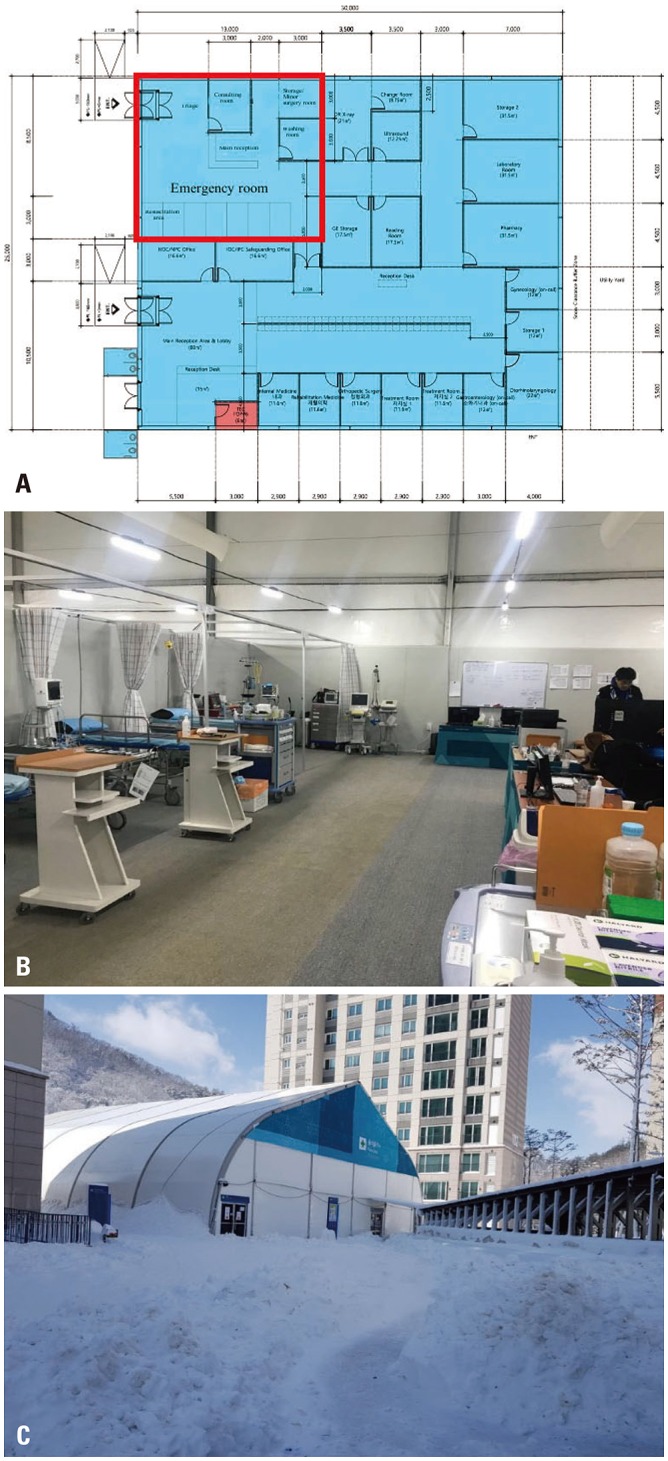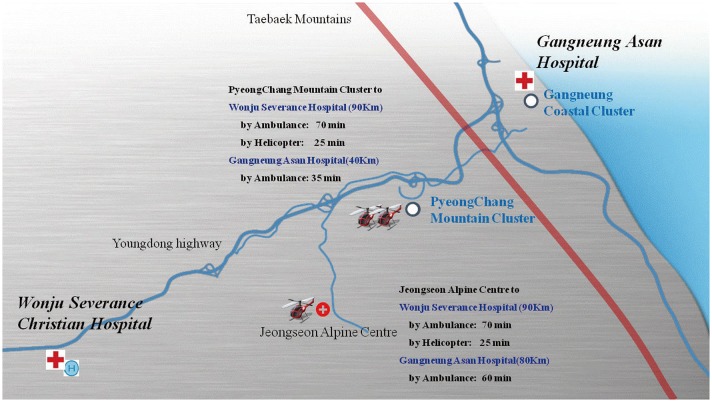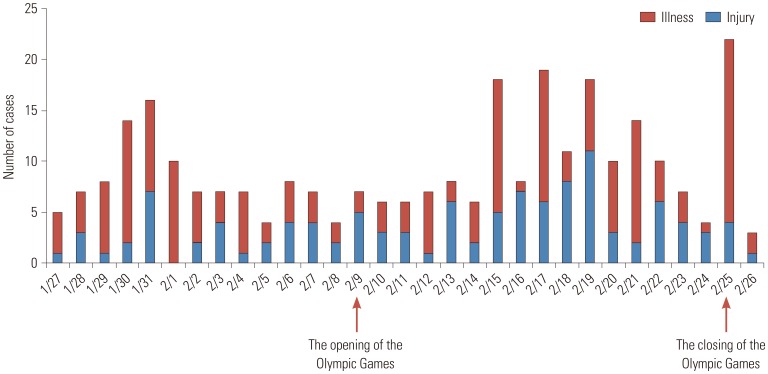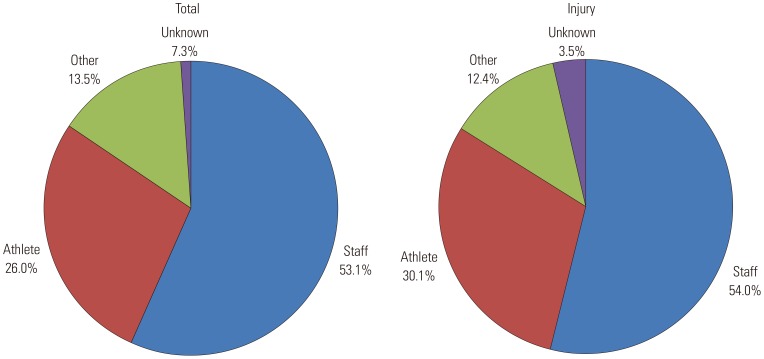Yonsei Med J.
2019 May;60(5):474-480. 10.3349/ymj.2019.60.5.474.
Experiences of the Emergency Department at the Pyeongchang Polyclinic During the 2018 PyeongChang Winter Olympic Games
- Affiliations
-
- 1Department of Surgery, Saidabad Clinic, Dhaka, Bangladesh.
- 2Department of Surgery, Yonsei University Wonju College of Medicine, Wonju, Korea. bksgs@yonsei.ac.kr
- 3Trauma Center, Wonju Severance Christian Hospital, Wonju, Korea.
- KMID: 2443252
- DOI: http://doi.org/10.3349/ymj.2019.60.5.474
Abstract
- PURPOSE
The 2018 PyeongChang Winter Olympic Games involved 2925 elite athletes, and providing proper health care services for these elite athletes was a critical priority. We established an emergency department (ED) in the Pyeongchang Mountain Polyclinic during the Olympics, which served staff and athletes from many countries. This experience, as well as a description of illnesses and injuries encountered during the games, may provide useful information for planning medical care at similar events in the future.
MATERIALS AND METHODS
The polyclinic ED operated from January 25 to February 27, 2018. All cases were enrolled in this study, and their data were analyzed by date and category. In addition, the number of injuries by body part, number of illnesses by organ system, and illness symptoms and causes were analyzed.
RESULTS
In total, 288 patients were encountered in the ED. These included 113 injuries and 175 illnesses. We consulted with 153 staff members and 75 athletes, and reported that the fingers were the most commonly injured body part, followed by the knee. The respiratory system was the most commonly involved organ system, and the most common cause of illness was infection. Thirty-eight influenza tests were performed, among which the results of seven were positive. We performed 17 norovirus tests, among which the results of four were positive.
CONCLUSION
Our analysis of our ED experience will aid arrangements for medical services in future Winter Games. Additionally, given our new experience, we will now be able to provide better medical services for future winter sports events.
MeSH Terms
Figure
Reference
-
1. Ljungqvist A, Jenoure P, Engebretsen L, Alonso JM, Bahr R, Clough A, et al. The International Olympic Committee (IOC) Consensus Statement on periodic health evaluation of elite athletes March 2009. Br J Sports Med. 2009; 43:631–643. PMID: 19734496.
Article2. Steffen K, Soligard T, Engebretsen L. Health protection of the Olympic athlete. Br J Sports Med. 2012; 46:466–470. PMID: 22661696.
Article3. Vanhegan IS, Palmer-Green D, Soligard T, Steffen K, O'Connor P, Bethapudi S, et al. The London 2012 Summer Olympic Games: an analysis of usage of the Olympic Village ‘Polyclinic’ by competing athletes. Br J Sports Med. 2013; 47:415–419. PMID: 23467963.
Article4. Reeser JC, Willick S, Elstad M. Medical services provided at the Olympic Village polyclinic during the 2002 Salt Lake City Winter Games. WMJ. 2003; 102:20–25. PMID: 12967017.5. Engebretsen L, Steffen K, Alonso JM, Aubry M, Dvorak J, Junge A, et al. Sports injuries and illnesses during the Winter Olympic Games 2010. Br J Sports Med. 2010; 44:772–780. PMID: 20820057.
Article6. Ruedl G, Schobersberger W, Pocecco E, Blank C, Engebretsen L, Soligard T, et al. Sport injuries and illnesses during the first Winter Youth Olympic Games 2012 in Innsbruck, Austria. Br J Sports Med. 2012; 46:1030–1037. PMID: 23148325.
Article7. Soligard T, Steffen K, Palmer-Green D, Aubry M, Grant ME, Meeuwisse W, et al. Sports injuries and illnesses in the Sochi 2014 Olympic Winter Games. Br J Sports Med. 2015; 49:441–447. PMID: 25631542.
Article8. Weiss BP, Mascola L, Fannin SL. Public health at the 1984 Summer Olympics: the Los Angeles County experience. Am J Public Health. 1988; 78:686–688. PMID: 3285705.
Article9. Thompson JM, Savoia G, Powell G, Challis EB, Law P. Level of medical care required for mass gatherings: the XV Winter Olympic Games in Calgary, Canada. Ann Emerg Med. 1991; 20:385–390. PMID: 2003667.
Article
- Full Text Links
- Actions
-
Cited
- CITED
-
- Close
- Share
- Similar articles
-
- Epidemiologic Study of Shoulder Injuries in the PyeongChang 2018 Winter Olympic Games
- The Experience of the Upper Respiratory Infection of the Elite Winter Sports Athletes and Its Effect on Training and Competition
- The Aging Study of Pyeongchang Rural Area (ASPRA): Findings and Perspectives for Human Aging, Frailty, and Disability
- The Analysis of Medical Services during Summer Universiade
- Injuries and Illnesses of Korean Athletes during the Almaty Winter Universiade Games 2017





